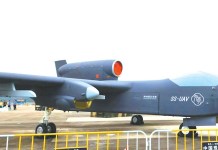As India looks to build its future fifth-generation fighter within its national boundaries, the country’s Defence Research and Development Organisation (DRDO) has begun work on setting up a new fighter jet engine complex to develop a 110 kilonewton powered engine.
Three Islamic Countries That May Never Recognize Israel Despite The Acceptance Of Saudi Arabia?
Having seen neighbours China sailing ahead with the development of indigenously produced fighters, the Indian Air Force (IAF) had rolled out plans to build an advanced multi-role fighter which would be powered by a new indigenously produced engine and home developed weapon systems.
According to reports, the new fighter jet complex under the leadership of DRDO will be a part of the HAL Advanced Medium Combat Aircraft (AMCA) program to produce future fifth-generation fighters, with advanced discussions already underway with a French manufacturer.

Under the programme, the new engine complex will take up to seven years to produce, with French engine manufacturer Safran offering a complete technology transfer to develop the engine and to use the offset credits from the French Dassault Rafale deal.
It is also looking to agree on a deal with HAL for the transfer of manufacturing technology for high-end engines.
“We are signing an agreement related to the technology needed for high thrust engine manufacturing. The technology will be common to the Rafale engines that can be supported by us and would also be useful for the 110 kn engine project,” said HAL Chairman R Madhavan, while speaking to Economic Times.
Inside America’s Trillion Dollar Disaster – How The US’ F-35 Jets Emerged From The Ashes?
According to reports, the new engine complex which is yet to be set up will be focused on developing high-end fighter jet engines as compared to HAL, who would cater to lower thrust engines for helicopters, light transport aircraft, drones (UAVs) and trainers.
The new engines will most probably equip the future squadrons of the IAF, as they would not be ready for the AMCA fighters which might be developed for the initial squadrons.
Moreover, the new complex will be a step forward for India to lessen its dependence on Russia and other Western nations for fighter jet engines. Another significant factor would be the immense cost-cutting due to the development of a homegrown engine.
However, the news of the engine complex comes at the back of a statement issued by the Comptroller and Auditor General of India on the Indian government’s offset policy for defence procurement.
The corporation stated that the transfer of technology to DRDO for reviving the stalled Kaveri engine programme has not been completed. “DRDO wanted to obtain Technical Assistance for the indigenous development of engine (Kaveri) for the Light Combat Aircraft. Till date, the Vendor has not confirmed the transfer of this technology,” the CAG says in its report.
According to Economic Times, India’s plans to use the Rafale offsets to obtain jet engine technology has been in the air since the last four years despite Safran holding dialogues with Indian stakeholders. “French companies can modify offset plans at any point but have a huge obligation – to the tune of 3.5 billion Euro – that need to be completed in the next three years, though this timeline can be extended by the government.”




